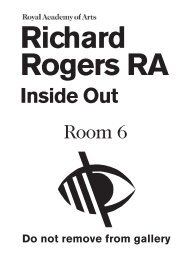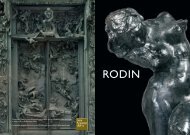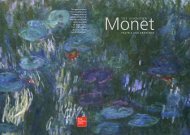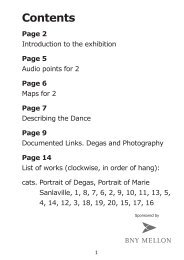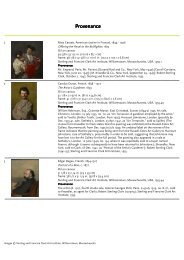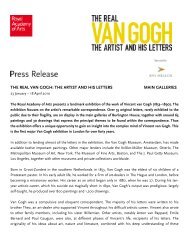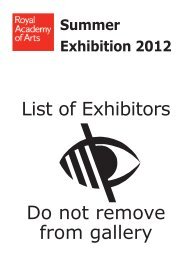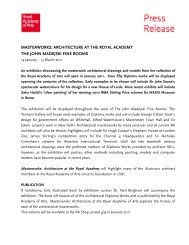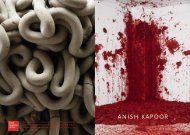The Three Emperors 1662–1795 - Royal Academy of Arts
The Three Emperors 1662–1795 - Royal Academy of Arts
The Three Emperors 1662–1795 - Royal Academy of Arts
Create successful ePaper yourself
Turn your PDF publications into a flip-book with our unique Google optimized e-Paper software.
This guide is given out free to teachers<br />
and students with an exhibition ticket<br />
at the Education Desk.<br />
It is available to other visitors from the<br />
RA Shop at a cost <strong>of</strong> £3.95 (while<br />
stocks last).<br />
CHINA<br />
<strong>The</strong> <strong>Three</strong> <strong>Emperors</strong><br />
<strong>1662–1795</strong>
CHINA<br />
<strong>The</strong> <strong>Three</strong> <strong>Emperors</strong><br />
<strong>1662–1795</strong><br />
Main Galleries,<br />
12 November 2005 – 17 April 2006<br />
Sponsored by<br />
An Introduction to the Exhibition<br />
for Teachers and Students<br />
Written by Dr Frances Wood<br />
For the Education Department<br />
© <strong>Royal</strong> <strong>Academy</strong> <strong>of</strong> <strong>Arts</strong><br />
front cover<br />
Cat. 11 (detail)<br />
A Scene Described in the Qianlong Emperor’s Poem<br />
‘Bird’s-Eye View <strong>of</strong> the Capital’ 1767 by Xu Yang<br />
<strong>The</strong> Palace Museum, Beijing<br />
back cover<br />
Cat. 173 (detail)<br />
From Twelve Beauties at Leisure Painted for Prince Yinzhen,<br />
the Future Yongzheng Emperor,<br />
late Xangxi period (between 1709 and 1723)<br />
<strong>The</strong> Palace Museum, Beijing<br />
Designed by Isambard Thomas, London<br />
Printed by Burlington<br />
INTRODUCTION<br />
By the end <strong>of</strong> the eighteenth century, China was the richest and most<br />
populous state in the world, and its territories, including parts <strong>of</strong><br />
Russia and Outer Mongolia, stretched across northern Central Asia<br />
as far as the Pamirs, covering twelve million square kilometres. In this<br />
exhibition we will be looking at the collections <strong>of</strong> the Qing emperors<br />
Kangxi, Yongzheng and Qianlong who were responsible for bringing<br />
the country to this state <strong>of</strong> relative unity and prosperity.<br />
HISTORY<br />
Although they are now thoroughly identified with China, the emperors<br />
<strong>of</strong> the Qing dynasty were not Chinese but descendants <strong>of</strong> the Jurchen,<br />
a group from the far north-east <strong>of</strong> China who had abandoned the<br />
term Jurchen, associated with historical submission to Chinese<br />
rule, and instead called themselves Manchu. <strong>The</strong>ir leader then<br />
proclaimed himself emperor <strong>of</strong> the Qing (pure, clear) dynasty and<br />
in 1644 replaced the Ming dynasty as rulers <strong>of</strong> China. During the<br />
seventeenth and eighteenth centuries, the problem <strong>of</strong> identity ,<br />
<strong>of</strong> the balance between ancestral heritage and Chinese culture,<br />
was gradually resolved.<br />
In the early stages <strong>of</strong> Manchu rule, the emperors still encountered<br />
considerable loyalty to the Chinese Ming dynasty. <strong>The</strong> Aisin-Gioro clan,<br />
to which the three Qing emperors belonged, had consolidated their<br />
power from the 1590s through the organisation <strong>of</strong> the Eight Banners.<br />
<strong>The</strong> Banners, military groups named for their distinctive banners,<br />
also formed the basis <strong>of</strong> social organisations that had been in place<br />
before the Manchu conquest <strong>of</strong> China, where warriors’ families were<br />
included in the groups and provided with educational opportunities<br />
and agricultural land. As the Qing moved southwards, they<br />
incorporated many Chinese (who eventually outnumbered the<br />
Manchus) into the Banners, providing for them and their families<br />
and thereby instilling loyalty. <strong>The</strong>se were the troops that the Kangxi<br />
emperor led against three rebellious Chinese generals, finally<br />
crushing their revolt in 1681.<br />
PAINTING<br />
Chinese resistance had to be defeated, but for the emperors Chinese<br />
culture was something to be admired and acquired. For thousands <strong>of</strong><br />
years, painting in China was considered, with calligraphy, to be one <strong>of</strong><br />
the highest forms <strong>of</strong> expression. Painters ranged in status from skilled<br />
studio craftsmen who produced paintings for the masses, to scholarartists<br />
who supposedly painted only for pleasure. An important<br />
painting instruction manual, <strong>The</strong> Mustard Seed Garden, published<br />
during the reign <strong>of</strong> the Kangxi emperor, included specified ways <strong>of</strong><br />
1
Cat. 120<br />
Anonymous court artists<br />
Portrait <strong>of</strong> the Kangxi Emperor in<br />
Informal Dress Holding a Brush<br />
Kangxi period 1662–1722<br />
Hanging scroll, ink and colour on silk<br />
50.5 x 31.9 cm<br />
<strong>The</strong> Palace Museum, Beijing<br />
painting various pictorial elements such as rocks and figures. Practice<br />
and concentration were required and the artist’s tools and materials<br />
played a significant role in the rituals that led to the perfecting <strong>of</strong><br />
his art.<br />
SCROLLS<br />
Painted on paper or silk, paintings came in two main formats: the<br />
hanging or vertical scroll, to be displayed on special occasions, and the<br />
hand scroll which, <strong>of</strong>ten extremely long, can only be examined three or<br />
four feet at a time as it is unrolled in sections. Significantly, Chinese<br />
painting does not present the viewer with a single ‘window’ into the<br />
world or a single perspective point, as a Western painting usually does,<br />
but rather with multiple perspectives that depend on where the<br />
viewer’s eye is engaged.<br />
THE MANCHUS<br />
<strong>The</strong> Manchus practised shamanism, a shaman (the only Manchu<br />
loan-word in fairly common usage in English) being someone believed<br />
to be capable <strong>of</strong> travelling to, communicating with and influencing<br />
the spirit world. <strong>The</strong> Manchus continued this practice after their<br />
conquest <strong>of</strong> China, claiming descent from an ancestor born after<br />
his mother held a fruit dropped from the mouth <strong>of</strong> a sacred magpie.<br />
In the Kunning gong (a former residence <strong>of</strong> the empresses <strong>of</strong> the<br />
Chinese Ming dynasty), a kitchen was installed for the preparation<br />
<strong>of</strong> sacrificial <strong>of</strong>ferings <strong>of</strong> meat, and spirit poles were erected to hoist<br />
up the <strong>of</strong>ferings for the magpies that roosted in the trees <strong>of</strong> the<br />
Forbidden City.<br />
It was not only the new emperor’s beliefs that differed from those<br />
<strong>of</strong> the Chinese: the Manchu language was quite unrelated to Chinese<br />
and closer to the Tungusic languages <strong>of</strong> northern Asia. Examples <strong>of</strong><br />
the script, adapted from the Mongolian, can still be seen, side by side<br />
with Chinese characters, on the name boards <strong>of</strong> the halls throughout<br />
the Forbidden City.<br />
THE KANGXI EMPEROR<br />
<strong>The</strong> Kangxi emperor (ruled 1661–1722) was a third son and was<br />
announced as heir when his father lay dying <strong>of</strong> smallpox. He himself<br />
had survived an attack <strong>of</strong> smallpox (to which the Manchus were<br />
particularly prone) and was therefore regarded as potentially longlived,<br />
which may have played a part in his choice as heir and in his<br />
reign name which means ‘healthy and splendid’. He later said that he<br />
had had all his children and soldiers inoculated, an age-old Chinese<br />
practice, by the inhalation <strong>of</strong> tiny pieces <strong>of</strong> infected skin. Through the<br />
2 3
4<br />
Cat. 13<br />
Wang Hui (1632–1717) and assistants<br />
<strong>The</strong> Kangxi Emperor’s Southern<br />
Inspection Tour, Scroll Eleven: Nanjing<br />
to Jinshan (detail)<br />
1691–98<br />
Handscroll, colour on silk<br />
67.8 x 2612 cm<br />
<strong>The</strong> Palace Museum, Beijing<br />
choice <strong>of</strong> a third son as heir, the Manchus broke with the Chinese<br />
imperial tradition <strong>of</strong> primogeniture. During the preceding Chinese<br />
Ming dynasty, the first-born son was raised in the Forbidden City and<br />
all his other brothers were sent away from the capital to prevent<br />
jealousy and intrigue. <strong>The</strong> Manchus, however, kept the emperor’s<br />
sons in the capital and, from the Yongzheng reign, decreed that they<br />
should all be educated together in the Palace School for Princes.<br />
Cat. 120 This portrait shows the youthful Kangxi emperor engaged in<br />
a ‘pleasurable activity’, calligraphy, which he practised daily, thereby<br />
giving the impression that a Manchu emperor might be a member, by<br />
proxy, <strong>of</strong> the Chinese literati. On the screen behind and on the richly<br />
coloured carpet, dragons protect the emperor. Dragons were <strong>of</strong>ten<br />
represented in clouds because they were associated with water. <strong>The</strong>y<br />
were also carved on wooden beams in the Imperial Palace, to protect<br />
the building from fire. Notice the fact that the emperor is about to<br />
start writing from right to left.<br />
How many different systems <strong>of</strong> perspective are used in<br />
this painting? Is the Western system represented?<br />
What effect do the grey dragon and cloud have when seen<br />
in conjunction with the rich colour elsewhere?<br />
<strong>The</strong> revolt <strong>of</strong> the three generals in the 1670s showed the Kangxi<br />
emperor that loyalty to the new dynasty was not automatic, so he<br />
sought to bring Chinese intellectuals to his aid by commissioning<br />
an <strong>of</strong>ficial history <strong>of</strong> the Ming dynasty. In 1679, he held a special<br />
examination to bring Chinese scholars into <strong>of</strong>ficial service, selecting<br />
learned men and good calligraphers for his Imperial Study. He<br />
commissioned many scholarly works such as a complete edition <strong>of</strong> the<br />
poems <strong>of</strong> the Tang dynasty and in 1716 a Kangxi dictionary which, with<br />
its 49,000 characters, set the outer boundaries <strong>of</strong> the Chinese script.<br />
He made six tours <strong>of</strong> inspection <strong>of</strong> southern China, paying particular<br />
attention to flood prevention and irrigation schemes to encourage<br />
agriculture. For the second <strong>of</strong> these trips he commissioned a pictorial<br />
record, which originally consisted <strong>of</strong> twelve scrolls showing more than<br />
700feet <strong>of</strong> painting, one <strong>of</strong> which (scroll 11) is partly on show in the<br />
exhibition (see cat. 13).<br />
Cat. 13 This scroll was designed by the famous scholar-painter Wang<br />
Hui (1632–1717) to record the Kangxi emperor’s visit to the cultural<br />
heart <strong>of</strong> China in the south. (Wang Hui himself came from this part <strong>of</strong><br />
China, from the lower Yangzi region.) A large team <strong>of</strong> figure, landscape<br />
and architectural painters worked on the huge project (originally<br />
twelve scrolls, altogether over 700 feet long) under Wang Hui’s<br />
supervision. Although minute, the figures are painted in the most vivid<br />
and individually expressive manner.<br />
What might be the benefits <strong>of</strong> multiple perspectives for viewing<br />
a scroll like this?<br />
What can be gained from the fact that the animated figures<br />
are so small?<br />
Would you say that the purpose <strong>of</strong> the scroll was to celebrate<br />
ordinary people, the emperor or both? Why do you think this?<br />
<strong>The</strong> Kangxi emperor also relaxed some <strong>of</strong> the more oppressive<br />
regulations imposed on the vanquished Chinese, ending inequalities<br />
<strong>of</strong> rank and salary between Manchus and Chinese who held parallel<br />
posts in his administration. In this way he became known as a<br />
conciliatory ruler, who attempted to encourage Chinese support<br />
<strong>of</strong> the dynasty.<br />
In the Manchu tradition, he was a good horseman and archer and<br />
an active participant in some <strong>of</strong> the military campaigns <strong>of</strong> his reign,<br />
such as the long pursuit <strong>of</strong> the Mongol leader Galdan, whom he drove<br />
‘<strong>The</strong> eleventh scroll respectfully<br />
depicts his majesty setting forth from<br />
the Western Water Gate <strong>of</strong> Jiangning<br />
(Nanjing), passing Stone Citadel and<br />
travelling through the dense forests<br />
and beautiful scenery from Guanyin<br />
Gate to Swallow Cliff. Sailing down<br />
the Yangzi, the ornate banners shone<br />
across the river and the mountains,<br />
the brilliance <strong>of</strong> the retinue outshone<br />
the sun and the clouds.’<br />
Preface <strong>of</strong> the scroll <strong>The</strong> Kangxi<br />
Emperor’s Southern Inspection Tour,<br />
Scroll Eleven: Nanjing to Jinshan<br />
5
6<br />
Cat. 11<br />
Xu Yang (fl.c.1751–1776)<br />
A Scene Described in the<br />
Qianlong Emperor’s Poem<br />
‘Bird’s-Eye View <strong>of</strong> the Capital’<br />
1767<br />
Hanging scroll, colour on silk<br />
255 x 233.8 cm<br />
<strong>The</strong> Palace Museum, Beijing<br />
out <strong>of</strong> Central Asia in 1697. Foreigners who met him, including<br />
Jesuits and members <strong>of</strong> the Dutch and Russian embassies,<br />
remembered him as intensely curious. He was fascinated by Western<br />
science, participating in the great contest between Jesuits and Court<br />
astronomers, choosing the former to head the Imperial Board <strong>of</strong><br />
Astronomy and teach him Western mathematics and science. In<br />
another break with the Ming Chinese tradition, he also summoned<br />
the French Jesuit Fr Gerbillon to teach him mathematics in his private<br />
quarters at the far end <strong>of</strong> the Forbidden City, previously closed to<br />
outsiders. Gerbillon also served as an interpreter in the border<br />
negotiations with Russia (1689) and in a geographical survey <strong>of</strong> China<br />
(1707–11). It is perhaps important to note that all his conversations<br />
with the emperor were conducted in Manchu, not Chinese.<br />
THE YONGZHENG EMPEROR<br />
According to Manchu tradition, the Kangxi emperor was succeeded by<br />
his fourth son, the Yongzheng emperor (who ruled from 1723 to 1736).<br />
His imperial title, Yongzheng, means ‘harmonious and correct’, whilst<br />
his family name, Yinzhen, means ‘inheritance <strong>of</strong> luck’. In some ways,<br />
his reign can be seen as a reaction against that <strong>of</strong> his father: where the<br />
Kangxi emperor was conciliatory, the Yongzheng emperor acted firmly<br />
against corruption, <strong>of</strong>fering bonuses to demonstrably incorruptible<br />
<strong>of</strong>ficials and thereby greatly improving the flow <strong>of</strong> revenue. Capable <strong>of</strong><br />
extremely hard work, he not only dealt with dozens <strong>of</strong> daily memorials<br />
(government reports) from all over the country, but he developed the<br />
system whereby ‘Palace Memorials’ established by his father came<br />
directly to him, bypassing <strong>of</strong>ficials <strong>of</strong> the Outer Court and providing<br />
him with private information.<br />
Cat. 11 In this view <strong>of</strong> the Forbidden City, painted in 1767 during the<br />
reign <strong>of</strong> the Qianlong emperor, we can see how Western single-point<br />
perspective is used brilliantly to express the actual progressive<br />
inaccessibility <strong>of</strong> the imperial palace: as we, the public, advance<br />
under a triumphal arch in front <strong>of</strong> the great Qian men gate through<br />
the Gate <strong>of</strong> Heavenly Peace (Tianan men) and the Meridian Gate<br />
into the palace itself, we can make out less and less, until the<br />
emperor’s private quarters at the very rear are almost hidden<br />
from view in the distance.<br />
Red is the colour <strong>of</strong> good fortune in China. How has it been<br />
used here?<br />
Is this a map or a painting, a record or an impression, or a bit<br />
<strong>of</strong> everything?<br />
What might the spiral in the top right-hand corner <strong>of</strong> the<br />
painting be?<br />
7
8<br />
‘<strong>The</strong>re is tea, made from fresh snow<br />
on a little brazier slung between two<br />
horses. <strong>The</strong>re is the perfect flavour <strong>of</strong><br />
fresh bream and carp from the<br />
mountain streams, caught by oneself<br />
in the early morning … <strong>The</strong>re is<br />
venison, roasted over an open fire by<br />
a tent pitched on the sunny slope <strong>of</strong> a<br />
mountain; or the liver <strong>of</strong> a newly-killed<br />
stag, cooked with one’s own hands<br />
(even if the rain is falling), and eaten<br />
with salt and vinegar.’<br />
<strong>The</strong> Xangxi Emperor<br />
It is clear that there was considerable rivalry between the Kangxi<br />
emperor’s twenty sons (he had had thirty-six but only twenty survived),<br />
since on his accession the Yongzheng emperor imprisoned a number<br />
<strong>of</strong> his brothers, and remained touchy about accusations that he had<br />
usurped the throne. In order to control imperial heirs, he insisted<br />
upon their all being taught in the school inside the Forbidden City<br />
and instructed in Confucian morals by the best Chinese teachers.<br />
He also instituted the practice <strong>of</strong> concealing the name <strong>of</strong> the<br />
designated heir in a box kept in the Qianqing hall, to be opened<br />
only after the emperor’s death.<br />
THE QIANLONG EMPEROR<br />
<strong>The</strong> Yongzheng emperor nominated his fourth son, Hongli, meaning<br />
‘Great Successor’, as his heir and he ruled from 1736 to 1796 as the<br />
Qianlong or ‘eminent sovereign’ emperor. He had been a great<br />
favourite <strong>of</strong> his grandfather, the Kangxi emperor, with whom he<br />
would go hunting as a boy. Some say that the Kangxi emperor chose<br />
Yongzheng as his successor so that he would eventually be succeeded<br />
by his grandson, although that would seem a rather risky prospect,<br />
as the Yongzheng emperor had ten sons (though only four survived<br />
into adulthood).<br />
<strong>The</strong> long reign <strong>of</strong> the Qianlong emperor (who retired in 1796,<br />
three years before his death) may be considered the height <strong>of</strong> the Qing.<br />
Though his Ten Great Campaigns were not all as successful as he<br />
claimed, he brought much <strong>of</strong> Central Asia under Qing rule, vastly<br />
increasing the size <strong>of</strong> his empire. <strong>The</strong> costs <strong>of</strong> his campaigns were<br />
met by an increase in cultivated land, with new crops, such as maize<br />
and peanuts, being grown and with firm controls on revenue<br />
collection. Well versed in Chinese culture, the Qianlong emperor<br />
is supposed to have written essays and as many as 42,000 poems.<br />
He developed the imperial collection, commissioning paintings<br />
and artefacts from Chinese and foreign artists, as well as collecting<br />
ancient Chinese objects and ordering the cataloguing <strong>of</strong> palace<br />
paintings and calligraphy.<br />
Cat. 263 Liu Ping was an insect and animal painter in a long Chinese<br />
tradition <strong>of</strong> illustrated fables. As with Aesop, it seems more telling to<br />
transpose stories showing human weakness or vulnerability through<br />
the animal or insect world. This painting shows three tree monkeys<br />
seemingly engaged in discussion, like three old men under a tree.<br />
How has the artist used the landscape to emphasise the relationship<br />
between the three monkeys?<br />
How does the fact that the top monkey disappears <strong>of</strong>f the frame<br />
affect the story and the sense <strong>of</strong> their conversation?<br />
Like his grandfather Kangxi, the Qianlong emperor made five great<br />
tours <strong>of</strong> inspection <strong>of</strong> southern China, reversing the tradition <strong>of</strong> the<br />
Ming emperors who only left the Forbidden City to visit the imperial<br />
altars but did not venture outside Peking.<br />
His daily routine was described in detail by the Jesuit priest<br />
Fr Benoist. He rose at six, ate alone at eight (his meal taking about 15<br />
minutes) and then read reports and memorials, discussing them with<br />
his ministers. He held an audience for newly appointed <strong>of</strong>ficials and<br />
had another brief solitary meal at two. <strong>The</strong>n he would read, write verse<br />
or paint and perhaps take some ‘light refreshment’ before bed. Unlike<br />
the Chinese, the Qianlong emperor took milk in his tea, with special<br />
herds <strong>of</strong> dairy cows providing the Manchu imperial family with milk.<br />
A menu for one <strong>of</strong> his meals in 1754 included a dish <strong>of</strong> fat chicken,<br />
boiled duck and bean curd, swallows’ nests and shredded smoked<br />
duck, smoked chicken, shredded stewed chicken, Chinese cabbage,<br />
salted duck and pork, bamboo-shoot steamed dumplings, rice cakes<br />
with honey and side dishes <strong>of</strong> pickled aubergine, pickled cabbage<br />
and cucumbers in soy sauce.<br />
Cat. 263<br />
Luo Ping<br />
From Insects, Birds and Beasts,<br />
leaf 9: Tree Monkeys<br />
1774<br />
One <strong>of</strong> ten album leaves, ink on paper<br />
20.8 x 27.5 cm each<br />
<strong>The</strong> Palace Museum, Beijing<br />
‘In the morning you see three<br />
<strong>of</strong> them, in the evening four,<br />
Princes transformed into old men,<br />
Each wearing a s<strong>of</strong>t fur coat,<br />
Monkeys, they are also known as the<br />
<strong>Three</strong> Dukes’<br />
Poem inscribed on Tree Monkeys<br />
painting<br />
9
10<br />
THE MANCHU HERITAGE<br />
Despite his absorption in Chinese high culture, the Qianlong emperor<br />
was ever conscious <strong>of</strong> his Manchu origins. His grandfather the Kangxi<br />
emperor wrote lyrically <strong>of</strong> the pleasure <strong>of</strong> being outdoors, in the<br />
mountains <strong>of</strong> the north-east.<br />
For the Kangxi emperor, hunting was more than simply killing<br />
game. (He boasted a lifetime bag <strong>of</strong> countless deer <strong>of</strong> different sorts,<br />
135 tigers, 25 leopards and 20 bears.) It was also a preparation for<br />
warfare and a test <strong>of</strong> discipline and organisation. In 1636, he wrote that<br />
the younger generation <strong>of</strong> Manchus was losing its traditional martial<br />
skills. <strong>The</strong> Qianlong emperor had his grandfather’s critical words<br />
carved on a stone stele near the Arrow pavilion in the Forbidden City<br />
where he presided over compulsory archery and riding competitions<br />
between the young princes.<br />
In order to pursue the joys <strong>of</strong> hunting and riding, all three emperors,<br />
Kangxi and Qianlong in particular, spent time away from the Forbidden<br />
City. <strong>The</strong> Kangxi emperor built himself a grand garden residence<br />
outside Peking and in 1703 began construction <strong>of</strong> a summer palace at<br />
Rehe (Hot Springs), now Chengde, some 150 kilometres northeast <strong>of</strong><br />
Peking. <strong>The</strong> Yongzheng emperor spent time in the Yuanming yuan<br />
garden (the Old Summer Palace) outside Peking, which was later<br />
greatly enlarged and elaborated by the Qianlong emperor. Qianlong<br />
also enlarged and improved the Rehe summer palace. He <strong>of</strong>ten spent<br />
most <strong>of</strong> the year away from the Forbidden City, but he was invariably<br />
followed by his entire court and all his ministers so that the work <strong>of</strong><br />
government and his daily routine, as described by Fr Benoist, could<br />
continue unchanged.<br />
<strong>The</strong> Manchus’ abiding love <strong>of</strong> riding and archery helped to create<br />
the style <strong>of</strong> their clothes. While the Ming emperors and their courtiers<br />
wore full, flowing robes with long, loose sleeves, the Manchus<br />
favoured tighter garments, buttoned down the right side, with narrow<br />
sleeves and split skirts (over trousers) for easier riding. <strong>The</strong> cuffs <strong>of</strong> the<br />
sleeves were cut in a horse-ho<strong>of</strong> shape, designed to protect the hands<br />
against the cold when riding and they wore long, dark, silk boots with<br />
thick soles in a lighter colour, whose stiffness enabled riders to stand<br />
in the stirrups. Manchu empresses and palace women wore similar<br />
robes to those <strong>of</strong> men with the same fastening and cuffs. <strong>The</strong><br />
Qianlong emperor criticised palace women for forgetting their<br />
Manchu origins if they adjusted their robes according to the Chinese<br />
wide-sleeved style or wore Chinese jewellery.<br />
According to the Qing dress code, Manchu women wore three<br />
earrings in each ear and, in the Manchu tradition, they did not bind<br />
their feet. <strong>The</strong>re seems to have been no attempt by the Manchus to<br />
prohibit foot-binding amongst Chinese women but they did, however,<br />
impose the Manchu hairstyle on all Chinese men, which caused much<br />
resentment. Chinese men were used to wearing their long hair in a<br />
loose bun under a cap, but the Manchus shaved the front <strong>of</strong> their head,<br />
growing the back hair and wearing it in a long plait. It is interesting to<br />
note that this hairstyle, an invariable part <strong>of</strong> the stereotype <strong>of</strong> the<br />
Chinese man for foreign visitors from the seventeenth century<br />
onwards, was not Chinese at all, but Manchu.<br />
RELIGION AND RITUAL<br />
<strong>The</strong> Manchu emperors continued the shamanistic daily <strong>of</strong>ferings <strong>of</strong><br />
their own tradition but also conformed to Chinese ritual by adopting<br />
Confucian values <strong>of</strong> rule both at home and in court. At the New Year<br />
and on their birthdays, they followed the Confucian practice <strong>of</strong> making<br />
<strong>of</strong>ferings to their ancestors in front <strong>of</strong> the ancestral portraits that were<br />
hung in the Imperial Ancestral Temple. <strong>The</strong> Chinese used a luni-solar<br />
calendar, requiring the insertion <strong>of</strong> an extra, or intercalary, month every<br />
few years to correct the shortfall <strong>of</strong> the lunar cycle. <strong>The</strong> New Year began<br />
with the first new moon after the winter solstice and, with the imperial<br />
almanacs reverently placed in sedan chairs for honourable dispatch<br />
throughout the country, the emperor himself initiated the agricultural<br />
year by ploughing a ceremonial furrow at the Altar <strong>of</strong> Agriculture. <strong>The</strong><br />
emperor’s plough was pulled by yellow oxen and his plough and trowel<br />
were also imperial yellow. <strong>The</strong> emperor was followed by the Minister <strong>of</strong><br />
Finance who flourished a whip, and the Viceroy <strong>of</strong> the Metropolitan<br />
Province, who carried a box <strong>of</strong> rice. Lesser <strong>of</strong>ficials ploughed, too, and<br />
the work was finished <strong>of</strong>f by peasants. <strong>The</strong> imperial grain produced<br />
here was reserved for sacrificial <strong>of</strong>ferings.<br />
Inside the Forbidden City was the Altar <strong>of</strong> the Earth and Grain,<br />
where the emperors prayed and made <strong>of</strong>ferings in spring and autumn<br />
and occasionally came to pray for rain during droughts and dry<br />
weather in times <strong>of</strong> flooding. In the western or ‘Sea’ palaces (today’s<br />
Beihai Park) there was an Altar to Silkworms where the empresses and<br />
palace women raised silkworms and made sacrifices to the Goddess <strong>of</strong><br />
Silkworms. Other traditional Chinese forms <strong>of</strong> worship continued by<br />
the Manchu emperors included the veneration <strong>of</strong> Confucius himself<br />
(in a shrine next door to the Imperial Study) and, in the Hall for the<br />
Transmission <strong>of</strong> the Mind, <strong>of</strong> gods such as Xiannong, traditionally said<br />
to have invented agriculture and pharmacology, and the legendary<br />
emperor Fu Xi who invented hunting, fishing and musical instruments.<br />
Wearing special robes <strong>of</strong> different colours (red for the sun and a fine,<br />
icy blue for the moon), the emperors made annual visits to the Altars<br />
to the Moon, Sun and Earth, built on the west, east and north <strong>of</strong> the<br />
city. One <strong>of</strong> the most significant ritual sites was the blue-tiled Temple<br />
<strong>of</strong> Heaven in the south <strong>of</strong> the city, next door to the Altar <strong>of</strong> Agriculture.<br />
At the winter solstice, the emperor travelled in a carriage pulled by<br />
elephants to the Temple <strong>of</strong> Heaven, where he prayed and <strong>of</strong>fered<br />
sacrifices to heaven and his ancestors and reported on the events <strong>of</strong><br />
‘<strong>The</strong> ruler is the Son <strong>of</strong> Heaven, he<br />
should make reverence for Heaven<br />
and concern for the people his first<br />
task. Only then will he obtain Heaven’s<br />
favour.’<br />
<strong>The</strong> Confucian view <strong>of</strong> the ruler’s<br />
duties as encapsulated by the<br />
Qianlong emperor<br />
11
12<br />
the old year. He would then return at the beginning <strong>of</strong> the New Year to<br />
pray for heaven’s favour. As well as shamanistic and Confucian rituals,<br />
the emperors included worship at a Daoist altar within the Forbidden<br />
City in their New Year activities. <strong>The</strong> Yongzheng emperor appointed<br />
forty-four Daoist priests to live in the Yuanming yuan, his summer<br />
palace just outside Peking. Within the Forbidden City, the emperors<br />
also followed traditional Chinese festival activities, letting <strong>of</strong>f<br />
firecrackers at the New Year to frighten evil spirits. On New Year’s Eve,<br />
like ordinary Chinese, they <strong>of</strong>fered cakes and sugar to the kitchen god,<br />
whose altar was above the stove, in order to sweeten his words when<br />
he made his annual visit to heaven to report on the family. <strong>The</strong><br />
Qianlong emperor participated in the kitchen god’s send-<strong>of</strong>f, beating a<br />
drum and, with his court <strong>of</strong>ficials lined up in front <strong>of</strong> him, singing a<br />
song called ‘<strong>The</strong> emperor in search <strong>of</strong> honest <strong>of</strong>ficials’ and letting <strong>of</strong>f<br />
fire-crackers.<br />
Cat. 15 As we have seen, the emperor, as giver <strong>of</strong> the calendar, led his<br />
people in seasonal activities. Here, in the Twelfth Lunar Month, the<br />
Yongzheng emperor is pictured in a Chinese gown, under a strange,<br />
solid, Western gateway in front <strong>of</strong> an apparently Western-style building<br />
with its stone balcony. <strong>The</strong> piled rocks and sparse prunus, appreciated<br />
in China for flowering in snow, and the leaf-shaped opening in the<br />
deer-filled bamboo grove are all characteristic <strong>of</strong> Chinese garden<br />
design, which stressed structure, form and seasonality rather than<br />
open vistas and mixed planting.<br />
Describe how the aerial and non-Western viewpoint benefits<br />
the spectator.<br />
Why do the Chinese particularly appreciate the fact that the<br />
prunus flowers so early?<br />
<strong>The</strong> emperor is engaged in watching something playful:<br />
the making <strong>of</strong> snow sculptures. What might the benefits be<br />
<strong>of</strong> this to his public image?<br />
TIBETAN BUDDHISM<br />
Perhaps the most significant religious and ritual practice <strong>of</strong> the early<br />
Qing was that <strong>of</strong> Tibetan Buddhism. It was a religion <strong>of</strong> great political<br />
significance in the areas bordering China, particularly since its <strong>of</strong>ficial<br />
adoption by Mongol rulers who remained the greatest threat to the<br />
Qing emperors. Participation in the Buddhist religion was therefore<br />
also <strong>of</strong> political significance and the Qing emperors established a<br />
somewhat unstable protectorate over Tibet. <strong>The</strong> three emperors built<br />
or restored thirty-two Tibetan Buddhist temples in Peking and eleven<br />
in the summer resort at Rehe, and sponsored a huge programme to<br />
translate 230 Tibetan Buddhist works into Mongolian.<br />
Cat. 15<br />
Anonymous court artists<br />
Portrait <strong>of</strong> the Yongzheng Emperor<br />
Enjoying Himself during the 12th lunar<br />
month (one <strong>of</strong> a set <strong>of</strong> twelve)<br />
Yongzheng period 1723–35<br />
Hanging scroll, colour on silk<br />
187.5 x 102 cm each<br />
<strong>The</strong> Palace Museum, Beijing<br />
13
14<br />
Fig 1<br />
Stupa<br />
Qianlong mark & period (1736–95)<br />
Gilded metal and silver inlaid with<br />
ruby, turquoise and lapis lazuli<br />
Height 167 cm<br />
<strong>The</strong> Palace Museum, Beijing<br />
Stupas were shrines built to hold holy<br />
relics or the ashes <strong>of</strong> the dead. This<br />
gold reliquary is in the same Tibetan<br />
form as the large, white stupa that<br />
dominates the Beihai park to the<br />
northeast <strong>of</strong> the Forbidden City.<br />
Demonstrating the Qing emperors’ seriousness about protecting<br />
and spreading the Buddhist faith, in 1720 the Kangxi emperor<br />
sponsored the printing <strong>of</strong> the Mongolian kanjur (Buddhist canon).<br />
This was translated into Mongolian and Manchu and published during<br />
the Qianlong emperor’s reign, when Peking was the centre <strong>of</strong><br />
Mongolian and Tibetan block-printing. To reinforce his relationship<br />
with Tibetan Buddhism, the Qianlong emperor had himself painted in<br />
a Tibetan tangka (a Tibetan Buddhist painting on cloth) as the<br />
Bodhisattva Manjusri, the Bodhisattva <strong>of</strong> wisdom, and holding the<br />
wheel symbol <strong>of</strong> the cakravartin (‘He who turns the wheel’, or the ideal<br />
world ruler) in his left hand. (A Bodhisattva is one who has achieved<br />
enlightenment and could enter nirvana but chooses to stay in the<br />
world to help others.) <strong>The</strong> painting was presented to the Panchen<br />
Lama <strong>of</strong> Tibet, perhaps as a reminder <strong>of</strong> the power, both temporal and<br />
spiritual, <strong>of</strong> the Qianlong emperor.<br />
Tibetan Buddhism was also attractive in an artistic sense,<br />
particularly to the Qianlong emperor. In porcelain, precious metals,<br />
and bricks and mortar, he commissioned works in the Tibetan style.<br />
Tall jugs <strong>of</strong> the sort that the Tibetans use for their buttered tea were<br />
made for the Forbidden City in porcelain and red lacquer. Buddhist<br />
halls in the palace were filled with cloisonné figures (enamel work in<br />
which the different colours are separated by strips <strong>of</strong> flattened wire<br />
placed edgeways on a metal backing), altar-pieces and stupas (see fig.<br />
1), and the grandest manifestation <strong>of</strong> this passion for the Tibetan style<br />
is seen in the temples built at Rehe, one <strong>of</strong> which is a replica <strong>of</strong> the<br />
great red Potala palace in Lhasa, the home <strong>of</strong> the Dalai Lamas.<br />
PATRONS OF THE ARTS<br />
It was especially in their patronage <strong>of</strong> the arts that the three emperors<br />
demonstrated their gradual adoption <strong>of</strong> Chinese forms (although they<br />
did distance themselves from Chinese tradition in certain areas).<br />
However, in their attitude to portraiture, they showed a certain<br />
independence. Traditionally, the function <strong>of</strong> portraiture in China had<br />
been largely restricted to that <strong>of</strong> ancestral worship and most (though<br />
not all) portraits were associated with death and mourning and were<br />
therefore stiff, formal representations. <strong>The</strong> Qing emperors, however,<br />
commissioned many portraits <strong>of</strong> themselves and their families that<br />
had no such associations. In the extraordinary commemorative album<br />
that shows the Yongzheng emperor in a variety <strong>of</strong> guises – as a Taoist,<br />
a fisherman, a hunter, a Buddhist and even in Western dress with curly<br />
wig, the style is far from that <strong>of</strong> a stiff ancestral portrait. Another<br />
Yongzheng-period album shows a series <strong>of</strong> court ladies, dressed in<br />
Chinese rather than Manchu clothing (in defiance <strong>of</strong> the <strong>of</strong>ficial dress<br />
code), sitting pensively in rooms filled with the very kind <strong>of</strong> antiquities<br />
that you will see in the exhibition.<br />
Cat. 173 This set <strong>of</strong> beautiful paintings <strong>of</strong> women was commissioned<br />
by the future Yongzheng emperor to cover a screen in his private study<br />
(the Deep Willows Reading Hall). <strong>The</strong>se are not portraits <strong>of</strong><br />
concubines, as has been thought, but <strong>of</strong> ideal women waiting and<br />
longing for love.<br />
Can you guess at the materials and textures that compose or<br />
cover objects in this painting?<br />
Can you find a visual equivalent for the woman’s feet? Why might<br />
her feet be hidden?<br />
What is the woman contemplating and why might this be?<br />
What does this painting reveal about the interior decoration<br />
<strong>of</strong> the Forbidden City?<br />
What can we learn from this painting about the idea <strong>of</strong><br />
female beauty at the time?<br />
<strong>The</strong> Qianlong emperor also had himself<br />
painted in a variety <strong>of</strong> guises: as a Buddhist<br />
bodhisattva, as a warrior, as a Chinese scholar<br />
in a loose Chinese gown and as a family man<br />
watching his children setting <strong>of</strong>f fire-crackers at<br />
New Year. In many <strong>of</strong> these paintings, a new<br />
style was evolved, combining Chinese and<br />
Western techniques. Though many Jesuit artists<br />
worked for the Qing court in the various<br />
workshops set up in the Forbidden City and in<br />
the summer palaces outside Peking, the most<br />
famous <strong>of</strong> these painters was Guiseppe<br />
Castiglione (1688–1766), who arrived at the<br />
court at the end <strong>of</strong> the Kangxi era. Castiglione<br />
taught many <strong>of</strong> the Chinese court artists and a<br />
number <strong>of</strong> ‘his’ paintings were composite<br />
efforts, where he worked on the face and figure<br />
while Chinese artists supplied the background.<br />
This procedure <strong>of</strong>ten created an interesting<br />
effect whereby a detailed Western-style<br />
depiction <strong>of</strong> a horse, bird or person existed in<br />
conjunction with a rather misty, sketched<br />
Chinese background. Castiglione, who took the<br />
Chinese name Lang Shining, pronounced Sherning,<br />
produced detailed portraits <strong>of</strong> favourite<br />
hunting dogs and glossy horses <strong>of</strong> the imperial<br />
stables.<br />
Jesuit courtiers have left amusing accounts<br />
<strong>of</strong> Qianlong’s views on painting. He had<br />
complained that people painted his head too<br />
Cat. 173<br />
Anonymous court artists<br />
From Twelve Beauties at Leisure<br />
Painted for Prince Yinzhen, the Future<br />
Yongzheng Emperor<br />
Late Kangxi period (between 1709<br />
and 1723)<br />
One <strong>of</strong> a set <strong>of</strong> twelve screen<br />
paintings, ink and colour on silk<br />
184 x 98 cm<br />
<strong>The</strong> Palace Museum, Beijing<br />
15
16<br />
small so that, when Jesuit artists prepared to paint him, eunuchs<br />
crowded in on them, indicating with their widespread hands that the<br />
head must be made bigger. Castiglione made several adaptations <strong>of</strong><br />
traditional Western methods, for example by painting with Chinese<br />
brushes. When he tried to paint within the Western tradition by<br />
indicating light and shade, the Qianlong emperor complained about<br />
dark blotches on his face, so Castiglione solved this problem by using<br />
a front-lit style to avoid excessive shadow.<br />
Cat. 65 In this almost life-size equestrian portrait <strong>of</strong> the youthful<br />
Qianlong emperor, Castiglione reveals both his Western artistic<br />
training and his Chinese adaptations.<br />
Identify where the artist is referring to Western artistic traditions<br />
and where to Chinese in terms <strong>of</strong> laws <strong>of</strong> perspective, light and<br />
dark (use <strong>of</strong> shadow) and subject matter.<br />
Do you think Castiglione’s portrait <strong>of</strong> the horse vies with that <strong>of</strong> the<br />
emperor in terms <strong>of</strong> charisma?<br />
<strong>The</strong> Qianlong emperor commissioned Jesuits to make drawings,<br />
subsequently reproduced as engravings in Paris, <strong>of</strong> his ten campaigns<br />
<strong>of</strong> conquest. All the emperors commissioned massive hand-scrolls by<br />
Chinese artists depicting important events. <strong>The</strong>se included imperial<br />
tours <strong>of</strong> southern China with winter receptions <strong>of</strong> ambassadors taking<br />
place on the frozen lakes <strong>of</strong> the Sea Palaces, and skating<br />
demonstrations by imperial soldiers on a surface <strong>of</strong> ice that had been<br />
smoothed with hand irons to prevent accidents.<br />
Important visitors, including foreign ambassadors, had to sit out<strong>of</strong>-doors<br />
in the freezing January weather, watching the skaters and<br />
waiting for little bowls <strong>of</strong> food to be presented to them from the<br />
emperor’s table. A Dutch embassy <strong>of</strong> 1794–5 recalled how each time a<br />
tiny yellow bowl containing cakes or ‘the remnants <strong>of</strong> gnawed-<strong>of</strong>f<br />
bones’ was sent over to them, to add insult to already perceived injury,<br />
they had to perform the ritual obeisance by kowtowing three times on<br />
the frozen ground.<br />
PORCELAIN<br />
<strong>The</strong> yellow porcelain food dishes formed part <strong>of</strong> the annual shipment<br />
<strong>of</strong> 10,000 items <strong>of</strong> tableware produced for the court at the great<br />
ceramic factories <strong>of</strong> Jingdezhen in Jiangxi province and shipped<br />
smoothly up the Grand Canal. Porcelain was not only required for the<br />
Forbidden City, but also for state rituals, where <strong>of</strong>ferings necessitated<br />
special coloured porcelain vessels, in deep blue for the Temple <strong>of</strong><br />
Heaven, yellow for the Temple <strong>of</strong> the Earth, red for the Temple <strong>of</strong> the<br />
Sun and blue-white for the Temple <strong>of</strong> the Moon. Decorations on<br />
Cat. 65<br />
Giuseppe Castiglione (Chinese name<br />
Lang Shining, 1688–1766)<br />
<strong>The</strong> Qianlong Emperor in Ceremonial<br />
Armour on Horseback<br />
1739 or 1758<br />
Hanging scroll (originally a tieluo<br />
painting), ink and colour on silk<br />
322.5 x 232 cm<br />
<strong>The</strong> Palace Museum, Beijing<br />
17
18<br />
porcelains made in Jingdezhen for the emperors frequently<br />
included complex decorative schemes involving equally complex<br />
puns upon words. For example, ‘Butterfly’ (romanised as die,<br />
pronounced dee-eh) also represented ‘longevity’, since the character<br />
for an eighty-year-old was also pronounced die, and the character for<br />
‘doubling’ (<strong>of</strong> happiness and fortune), also pronounced die, meant<br />
to ‘redouble’.<br />
Although many porcelains, produced under supervision in the<br />
imperial factories in Jingdezhen, were shipped fully glazed, many with<br />
plain glazes were further decorated in palace workshops where a fine<br />
range <strong>of</strong> enamels were applied. Jesuits, having achieved very little in<br />
the way <strong>of</strong> conversion to Catholicism, by the mid-eighteenth century<br />
had accepted that their role was to serve as handicraftsmen and artists<br />
to the court. <strong>The</strong>y worked repairing and making clocks, painting, and<br />
making a wide variety <strong>of</strong> snuff-bottles. <strong>The</strong>se tiny items, <strong>of</strong>ten used like<br />
the curly gnarled sticks or ruyi (which means ‘may everything go as you<br />
wish’) as <strong>of</strong>ficial gifts, were made in a variety <strong>of</strong> materials. However, it<br />
is clear that glass, which had hardly been used in China before the<br />
Qianlong era, was particularly popular. <strong>The</strong> Qianlong emperor<br />
appointed two Jesuits to run the imperial glass workshop in the<br />
Yuanming yuan and they were soon sending home to Europe for<br />
chemicals to colour glass in new ways and supervising the enamelling<br />
<strong>of</strong> Western scenes on the tiny bottles.<br />
Cat. 109 Glass was hardly known in China until European Jesuits<br />
introduced its manufacture into the palace. This delicate glass snuff<br />
bottle was formed in the shape <strong>of</strong> a double gourd, an auspicious<br />
symbol <strong>of</strong> fertility, being full <strong>of</strong> seeds. <strong>The</strong> double gourd also<br />
represented a door through which certain people with miraculous<br />
powers could enter a parallel paradise. <strong>The</strong> decoration on the bottle<br />
includes bats, also auspicious symbols since the Chinese word for<br />
bat (fu) sounds like the word for ‘happiness’.<br />
One <strong>of</strong> the Qianlong emperor’s particular interests was the<br />
development <strong>of</strong> the palace collection. In this he showed a mastery<br />
<strong>of</strong> Chinese culture, collecting ancient jades and bronzes and the best<br />
painting and calligraphy that could be found. Like the Yongzheng<br />
emperor before him, he had special boxes made for the new arrivals<br />
in his collection and, to the consternation <strong>of</strong> some critics, stamped<br />
personal seals and wrote appreciative colophons across ancient<br />
masterpieces <strong>of</strong> Chinese art. While he was only following the<br />
Chinese tradition by which each new owner <strong>of</strong> an ancient painting<br />
might append his seal and his words <strong>of</strong> appreciation, the Qianlong<br />
emperor did this in a characteristically grand style, his seals and<br />
calligraphy almost obliterating the original.<br />
<strong>The</strong> Qianlong emperor embarked on a massive project to<br />
collect ancient literature. His plan, to collect ‘the Complete Library<br />
in Four Collections’, was intended to<br />
preserve every important Chinese work<br />
written throughout its long history.<br />
<strong>The</strong>re was a darker side to the project,<br />
since his emissaries used the opportunity<br />
to seek out seditious works, particularly<br />
those that criticised the Manchu. <strong>The</strong><br />
authors <strong>of</strong> these works, and even their<br />
descendants, were savagely punished in<br />
one <strong>of</strong> the greatest literary inquisitions <strong>of</strong><br />
all time. <strong>The</strong> finished work (on which 300<br />
scholars and 3,800 scribes worked for ten<br />
years) resulted in 36,000 hand-written<br />
volumes <strong>of</strong> which seven copies were<br />
made for different imperial palaces.<br />
<strong>The</strong> contributions <strong>of</strong> the three<br />
emperors to Chinese culture were<br />
considerable: porcelain production at<br />
Jingdezhen reached new heights, ancient<br />
treasures were gathered within the<br />
imperial palaces, and Chinese literature<br />
was preserved for posterity.<br />
THE FOUR TREASURES<br />
<strong>The</strong> painter and calligrapher had four<br />
basic tools: brush, inkstick, inkstone and<br />
paper, all <strong>of</strong> which were manufactured<br />
with the utmost care. Brushes were made<br />
from animal hair graded into a sharp<br />
point and glued into bamboo or reed holders. Ink was derived<br />
from soot and animal glue, cooked, pounded, hardened and<br />
matured in <strong>of</strong>ten elaborately decorated moulds. This ink stick,<br />
lasting for years, was highly prized by artists and calligraphers,<br />
who ground it themselves with water on a jade or slate inkstone,<br />
while meditating on the work ahead. Paper, invented in China long<br />
before anywhere else, was used both as a ground and as a backing<br />
to works on silk.<br />
Cat. 231 This low table belonged to the Qianlong emperor. <strong>The</strong> object<br />
that appears to be a book with ivory sides is really a box, holding the<br />
Yangzi-period rhyming dictionary. <strong>The</strong> objects you see spread out in<br />
front all fit cunningly in to the various carved boxes on top <strong>of</strong> the table.<br />
Lacquer was highly prized and extremely labour-intensive in its<br />
production.<br />
Cat. 109<br />
Gourd-shaped snuff bottle with<br />
painted enamel design <strong>of</strong> flowers,<br />
gourds and bats<br />
Qianlong period 1736–95<br />
Glass and painted enamel<br />
6.4 x 3.2 cm<br />
<strong>The</strong> Palace Museum, Beijing<br />
19
20<br />
Cat. 231<br />
Writing set<br />
Qianlong period 1736–95<br />
Carved red lacquer, cloisonné enamel,<br />
ivory and other materials<br />
18.5 x 29 x 25.5 cm<br />
<strong>The</strong> Palace Museum, Beijing<br />
What modern Western technologically advanced equivalent can you<br />
think <strong>of</strong> for this writing table with its incredibly elegant design<br />
and almost fetishistic properties?<br />
<strong>The</strong> Kangxi and Qianlong emperors made many trips to southern<br />
China, inspecting and learning, keeping local <strong>of</strong>ficials on their toes<br />
and imbibing some <strong>of</strong> the classic scenes <strong>of</strong> the south and its garden<br />
cities. <strong>The</strong>y were relatively open to new ideas, making use <strong>of</strong> the skills,<br />
whether astronomical or artistic, <strong>of</strong> the Western Jesuits at the court.<br />
At the same time, many aspects <strong>of</strong> their Manchu heritage were also<br />
preserved. For example, empresses and concubines, ranked in<br />
a hierarchy that altered with the birth <strong>of</strong> imperial sons, were all<br />
selected from Manchu or Mongol families, never Chinese. As regards<br />
politics and religion, Qing tastes and interests still lay with northern<br />
and western neighbours. Despite the apparent splendour <strong>of</strong> late<br />
eighteenth-century China, Lord Macartney, who had led an<br />
unsuccessful British mission there hoping for freer trade and<br />
diplomacy, envisaged a perilous future after the death <strong>of</strong> the<br />
great Qianlong emperor.<br />
<strong>The</strong> three emperors’ successors were no match for the greed <strong>of</strong><br />
the West for trade nor for the military might used to enforce it, and<br />
an unhappy nineteenth century followed the glorious, ‘long’<br />
eighteenth century.<br />
‘<strong>The</strong> Empire <strong>of</strong> China is an old,<br />
crazy, First-rate man-<strong>of</strong>-war which<br />
a fortunate succession <strong>of</strong> able and<br />
vigilant <strong>of</strong>ficers has contrived to<br />
keep afloat for these one hundred and<br />
fifty years past and to overawe their<br />
neighbours merely by her bulk and<br />
appearance, but whenever an<br />
insufficient man happens to have<br />
command upon deck, adieu to the<br />
discipline and safety <strong>of</strong> the ship. She<br />
may perhaps not sink outright; she<br />
may drift some time as a wreck, and<br />
will then be dashed to pieces on the<br />
shore; but she can never be rebuilt<br />
on the old bottom.’<br />
An Embassy to China: Being the<br />
journal kept by Lord Macartney during<br />
his embassy to the Emperor Ch’ienlung,<br />
1794<br />
FURTHER READING<br />
Evelyn Rawski, <strong>The</strong> Last <strong>Emperors</strong>: A Social History <strong>of</strong> Qing Imperial<br />
Institutions, Berkeley, 1998.<br />
Pamela Crossley, <strong>The</strong> Manchus, Oxford, 1997.<br />
Jonathan Spence, Emperor <strong>of</strong> China: Self-portrait <strong>of</strong> K’ang-hsi,<br />
London, 1974.<br />
Craig Clunas, Art in China, Oxford, 1997.




